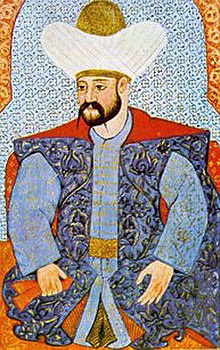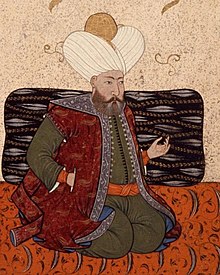Murad I
| Murad I | |||||
|---|---|---|---|---|---|
| |||||
 Miniature of Murad I from a 16th-century manuscript | |||||
| Sultan of the Ottoman Empire(Padishah) | |||||
| Reign | March 1362 – 15 June 1389 | ||||
| Predecessor | Orhan | ||||
| Successor | Bayezid I | ||||
| Born | 29 June 1326 Bursa,[1][2]Ottoman Beylik | ||||
| Died | 15 June 1389(aged 62) Kosovo field,District of Branković | ||||
| Burial | Organs buried atTomb of Murad I,Kosovo 42°42′07″N21°06′15″E/ 42.70194°N 21.10417°E Body buried at Sultan MuradTürbe,Osmangazi,Bursa | ||||
| Consorts | Gülçiçek Hatun Thamara Hatun Paşa Melek Hatun Others | ||||
| Issue Among others | Savci Bey Bayezid I Yakub Çelebi Nefise Hatun | ||||
| |||||
| Dynasty | Ottoman | ||||
| Father | Orhan | ||||
| Mother | Nilüfer Hatun | ||||
| Religion | Sunni Islam | ||||
| Tughra |  | ||||
Murad I(Ottoman Turkish:مراد اول;Turkish:I. Murad, Murad-ı Hüdavendigâr(nicknamedHüdavendigâr,fromPersian:خداوندگار,romanized:Khodāvandgār,lit. 'the devotee ofGod' – meaning "sovereign"in this context); 29 June 1326 – 15 June 1389) was thesultan of the Ottoman Empirefrom 1362 to 1389. He was the son ofOrhan GaziandNilüfer Hatun.Murad I came into the throne after his elder brotherSüleyman Pasha's death.
Murad Iconquered Adrianople,renamed it toEdirne,[2]and in 1363 made it the new capital of the Ottoman Sultanate.[3]Then he further expanded the Ottoman realm inSouthern Europeby bringing most of theBalkansunder Ottoman rule, and forced the princes ofSerbiaandBulgariaas well as theByzantineemperorJohn V Palaiologosto pay him tribute.[2]Murad I administratively divided his sultanate into the two provinces ofAnatolia(Asia Minor) andRumelia(the Balkans).
Titles[edit]
According to the Ottoman sources, Murad I's titles includedBey,Emîr-i a’zam(GreatEmir),Ghazi,Hüdavendigâr,Khan,Padishah,Sultânü’s-selâtîn(Sultan of sultans),Melikü’l-mülûk(Malikof maliks), while in Bulgarian and Serbian sources he was referred to asTsar.In aGenoesedocument, he was referred to asdominus armiratorum Turchie(Master lord of Turks).[4]
Wars[edit]


Murad fought against the powerfulbeylikofKaramaninAnatoliaand against theSerbs,Albanians,BulgariansandHungariansin Europe. In particular, a Serb expedition to expel the Turks from Adrianople led by the Serbian brothers KingVukašinandDespotUglješa,was defeated on September 26, 1371, by Murad's capable second lieutenantLala Şâhin Paşa,the first governor (beylerbey) ofRumeli.In 1385,Sofiafell to theOttomans.In 1386, PrinceLazar Hrebeljanovićdefeated an Ottoman force at theBattle of Pločnik.The Ottoman army suffered heavy casualties, and was unable to captureNišon the way back.
Battle of Kosovo[edit]


In 1389, Murad's army fought the Serbian Army and its allies under the leadership of Lazar at theBattle of Kosovo.
There are different accounts from different sources about when and how Murad I was assassinated. The contemporary sources mainly noted that the battle took place and that both Prince Lazar and the Sultan lost their lives in the battle. The existing evidence of the additional stories and speculations as to how Murad I died were disseminated and recorded in the 15th century and later, decades after the actual event. One Western source states that during the first hours of the battle, Murad I was assassinated by Serbian nobleman andknightMiloš Obilićby knife.[5][6]Most Ottoman chroniclers (includingDimitrie Cantemir)[7]state that he was assassinated after the finish of the battle while going around the battlefield. His older sonBayezid,who was in charge of the left wing of the Ottoman forces, took charge after that. His other son,Yakub Bey,who was in charge of the other wing, was called to the Sultan's command center tent by Bayezid, but when Yakub Bey arrived he was strangled, leaving Bayezid as the sole claimant to the throne.
In a letter from the Florentine senate (written byColuccio Salutati) to the KingTvrtko I of Bosnia,dated 20 October 1389, Murad I's (and Yakub Bey's) killing was described. A party of twelve Serbian lords slashed their way through the Ottoman lines defending Murad I. One of them, allegedlyMiloš Obilić,had managed to get through to the Sultan's tent and kill him with sword stabs to the throat and belly.[8][page needed]
Murad's internal organs were buried in Kosovo field and remain to this day on a corner of the battlefield in a location calledMeshed-i Hudavendigarwhich has gained a religious significance for the local Muslims. It was vandalized between 1999 and 2006 and was renovated recently.[when?]His other remains were carried toBursa,hisAnatoliancapital city, and were buried in a tomb at the complex built in his name.[9]
Family[edit]
Murad was the son ofOrhanandNilüfer Hatun,a slave concubine who was of ethnicGreekdescent.[10][11]
Consorts[edit]
Murad I had at least seven consorts:[12][13][14][15][16]
- Gulçicek Hatun.Slave concubine, mother of Bayezid I.
- FülaneHatun. Daughter of Ahî Seyyid Sultân, married Murad in 1366.
- Paşa Melek Hatun. Daughter of Kızıl Murad Bey.
- FülaneHatun. Daughter ofKonstantin of Kostendil,she married Murad in 1372. Two of her sisters married two of Murad's sons, Bayezid I and Yakub Çelebi.
- Kera Tamara Hatun.Bulgarian princess, daughter of TsarIvan Alexander of Bulgaria.Renowned for her beauty, she was forced to marry Murad when he conqueredBulgaria,in 1378.
- FülaneHatun. Daughter ofCândâroğlu Süleyman II Paşah,she married Murad in 1383. Her mother was Sultan Hatun, daughter ofSüleyman Pasha,Murad's older half-brother.
- Maria Hatun. Born Maria Paleologa, she was the daughter of the Byzantine emperorJohn Vand his wifeHelena Kantakouzene.She married Murad in 1386.[17]
Sons[edit]
Murad I had at least five sons:[12][13][15][16]
- Savci Bey(died in 1374). Executed by his father after he rebelled against him. He had a son, Davud Murad Bey, who fled to Hungary when his father died.
- Bayezid I(1360 - 1403) - with Gulçiçek Hatun. Ottoman Sultan.
- Yakub Çelebi(c.1362 - 20 June 1389). Strangled on Bayezid's orders.
- Ibrahim Bey (c.1365 -c.1385). Buried in the Osman I mausoleum.
- Yahşi Bey (? - before 1389) - with Gülçiçek Hatun.
Daughters[edit]
Murad I had at least five daughters:[13][15][16]
- Nefise Melek Sultan Hatun(c.1363 - after 1402). She was married off toKaramânoğlu Alâeddîn Alî Beyin an unsuccessful attempt to stop the war. She had at least three sons by him:Mehmed II Bey(1379 - 1423),Alaeddin Ali II Bey(1381 - 1424) and Oğuz Bey (probably died in infancy). Widowed in 1397, she returned to live in Bursa, but on the death of Bayezid I returned toKaraman,where her eldest son assumed the throne.
- Özer Hatun. She married and had issue. In 1426 her grandson Mehmed Bey held a post at court ofMurad II.
- Erhundi Hatun. She marriedSaruhânoğluHızır Bey before 1389.
- Mihriali Devlet Sultan Hatun. She marriedKaramânogluTurgut Bey, by whom she had a son, Mahmud Bey.
- Nilüfer Hatun. She built a mosque at Bursa.
Further reading[edit]

- Harris, Jonathan,The End of Byzantium.New Haven and London: Yale University Press, 2010.ISBN978-0-300-11786-8
- Imber, Colin(2009).The Ottoman Empire, 1300–1650: The Structure of Power(Second ed.). Basingstoke: Palgrave Macmillan.ISBN978-1-1370-1406-1.
References[edit]
- ^"Murad I".TheOttomans.org.
- ^abc"Murad I".Encyclopædia Britannica Inc., 2014. Web. 19 Dec. 2014.
- ^"In 1363 the Ottoman capital moved from Bursa to Edirne, although Bursa retained its spiritual and economic importance."Ottoman Capital Bursa.Official website of Ministry of Culture and Tourism of the Republic of Turkey. Retrieved 19 December 2014.
- ^Halil İnalcık (2006)."Murad I".TDV Encyclopedia of Islam, Vol. 31 (Muhammedi̇yye – Münâzara)(in Turkish). Istanbul:Turkiye Diyanet Foundation,Centre for Islamic Studies. pp. 156–164.ISBN978-975-389-458-6.
- ^Helmolt, Ferdinand.The World's History,p.293. W. Heinemann, 1907.
- ^Fine, John.The Late Medieval Balkans,p. 410. University of Michigan Press, 1994.ISBN0-472-08260-4.
- ^Cantemir, Dimitrie,History of the Growth and Decay of the Osman Ottoman Empire,London 1734.[page needed]
- ^Wayne S. Vucinich, Thomas A. Emmert (1991).Kosovo: Legacy of a Medieval Battle.University of Minnesota.ISBN9789992287552.
- ^"Meşhed-i Hüdavendigar – sultanmurad"(in Turkish).Retrieved2019-01-14.
- ^Peirce, Leslie P. (1994).Imperial Harem: Women and Sovereignty in the Ottoman Empire.Studies in Middle Eastern History. New York: Oxford University Press. pp. 33–35.ISBN978-0-19-508677-5.
- ^Lowry, Heath (2003).The Nature of the Early Ottoman State.Albany: SUNY Press. p. 153.ISBN0-7914-5636-6.
- ^abNikolay Antov - The Ottoman Wild West
- ^abcMustafa Çağatay Uluçay - Padişahların Kadınları ve Kızları
- ^Jennifer Lawler - Encyclopedia of the Byzantine Empire
- ^abcNecdet Sakaoğlu - Bu Mülkün Kadın Sultanları
- ^abcYılmaz Öztuna, Devletler ve Hanedanlar Cilt 2
- ^Several ofJohn V's daughters and granddaughters married Ottoman princes: his daughter Maria marriedMurad I,two more his sonsBayezid IandYakub,while a fourth, Irene, married Halil, Murad's half-brother. Two granddaughters, daughters ofTheodoreandZampia,married a son and grandson of Bayezid I,SüleymanandMustafa.
External links[edit]
![]() Media related toMurad Iat Wikimedia Commons
Media related toMurad Iat Wikimedia Commons
- .Encyclopædia Britannica.Vol. 19 (11th ed.). 1911. p. 14.

